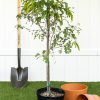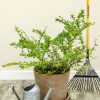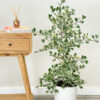Description
The Pride of Barbados will Dignify your Plant CollectionThe Caesalpinia pulcherrima is native to Central and South America. This plant has foliage similar to ferns and orange-colored flowers that resemble butterflies. This plant is known as Pride of Barbados and Orange Dwarf Poinciana. It is an ornamental plant famous for its beauty. You can ideally grow it in your garden or indoors. The Indonesians and West Indians often use it for medicinal purposes. However, it is best to keep it out of the reach of cats and dogs as the plant is toxic to them. Caring for your Orange Dwarf PoincianaYou may not be experienced when it comes to growing the Orange Dwarf, but with just a little love and care, your plant can grow and bloom beautifully. It is best to start with a small plant rather than getting leaves. Growing a small plant will be easier, and you will also be able to get results as soon as possible. Follow this care guide, and you will be good to go. LightKeeping its native habitat in mind, the plant is not tolerant of low light. It grows outdoors, so you will need to give it direct sunlight for long hours. Without a lot of sunlight, your plant may wilt. You can keep the plant in the garden or near a window, so it gets the most sun exposure. Some shade is acceptable for the plants, so it is okay if it does not get direct sunlight as long as it gets plenty of light. SoilThe best choice for soil for the Orange Dwarf Poinciana is sandy and well-drained soil that can give you the best drainage. You can also add a bit of peat to the soil mixture, which can help improve the drainage of your soil. WaterIf you want your plant to grow to its full potential, you must water it frequently. Water the plant regularly in the summer. Do not let the soil dry out completely, damaging the plant’s growth. During the winter, you do not need to water your plant regularly. FertilizerThere is no evident need for fertilizer for your Orange Dwarf Poinciana. However, you can feed it good quality fertilizer during the summer and spring. Providing fertilizer every two weeks can be great for the plant’s growth. Common IssuesThis plant is as robust as they come! There are not many diseases or pests that can harm the plant. However, keeping your plants safe from all problems is essential. PestsDifferent pests such as spider mites, scales, and other insects can damage the foliage and turn the leaves yellow. Check for pest infestation and avoid the insects using neem oil and other insecticidal soap. DiseaseDifferent diseases can affect the plant’s growth, such as Downy Mildew and powdery mildew. If your plant is kept in a moist environment, it may suffer from large white patches on the leaves. If you find such leaves, you must separate them immediately so the disease does not catch on to other leaves. PruningYou do not need to prune the plant, but if you want, you can prune it in late autumn or the winter. It is best to do it after the plant has bloomed. PropagationYou can successfully propagate the plant using seeds. You can get these seeds from a mature plant and remove the stalks. You can then put the seeds in the paper bag and let them dry out completely. Potting / RepottingYou can re-pot the plant when it grows too big for the plot. Make sure you use a plot that’s well draining and big enough for the new plant.





